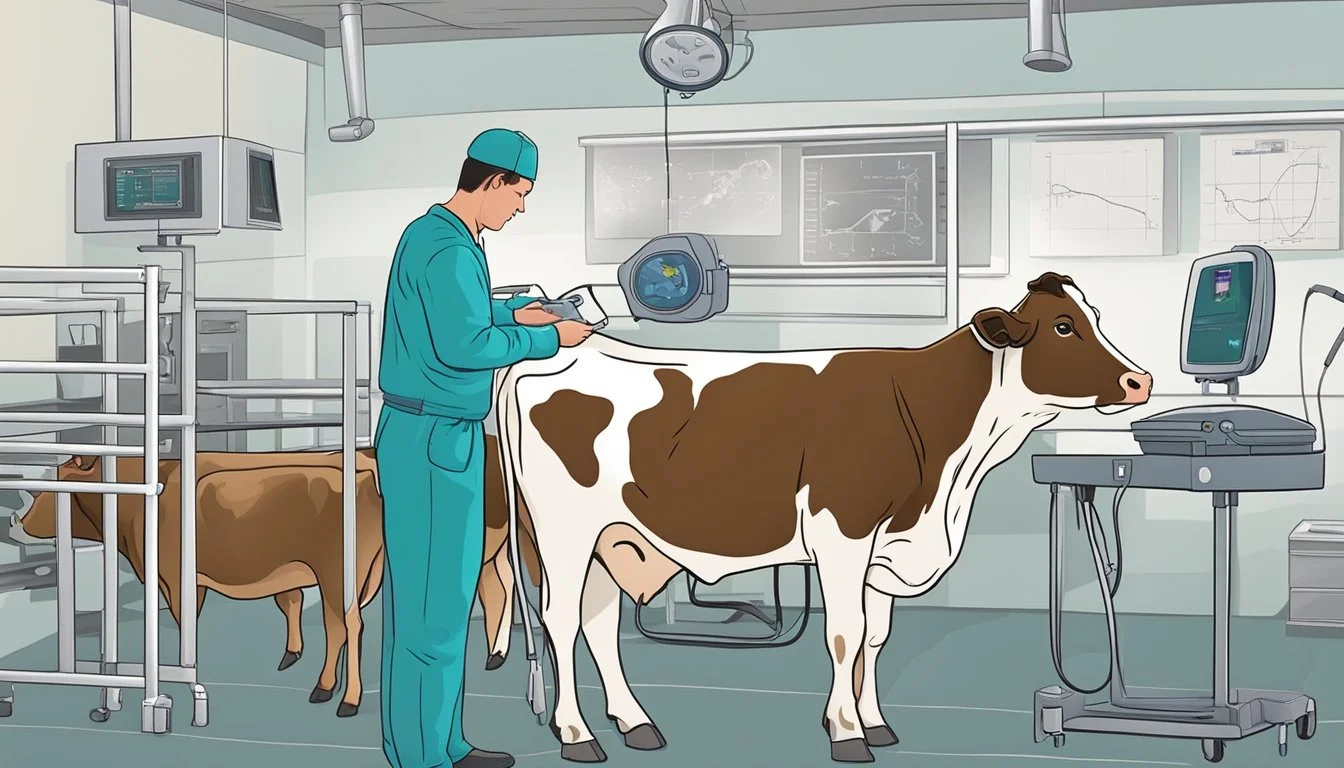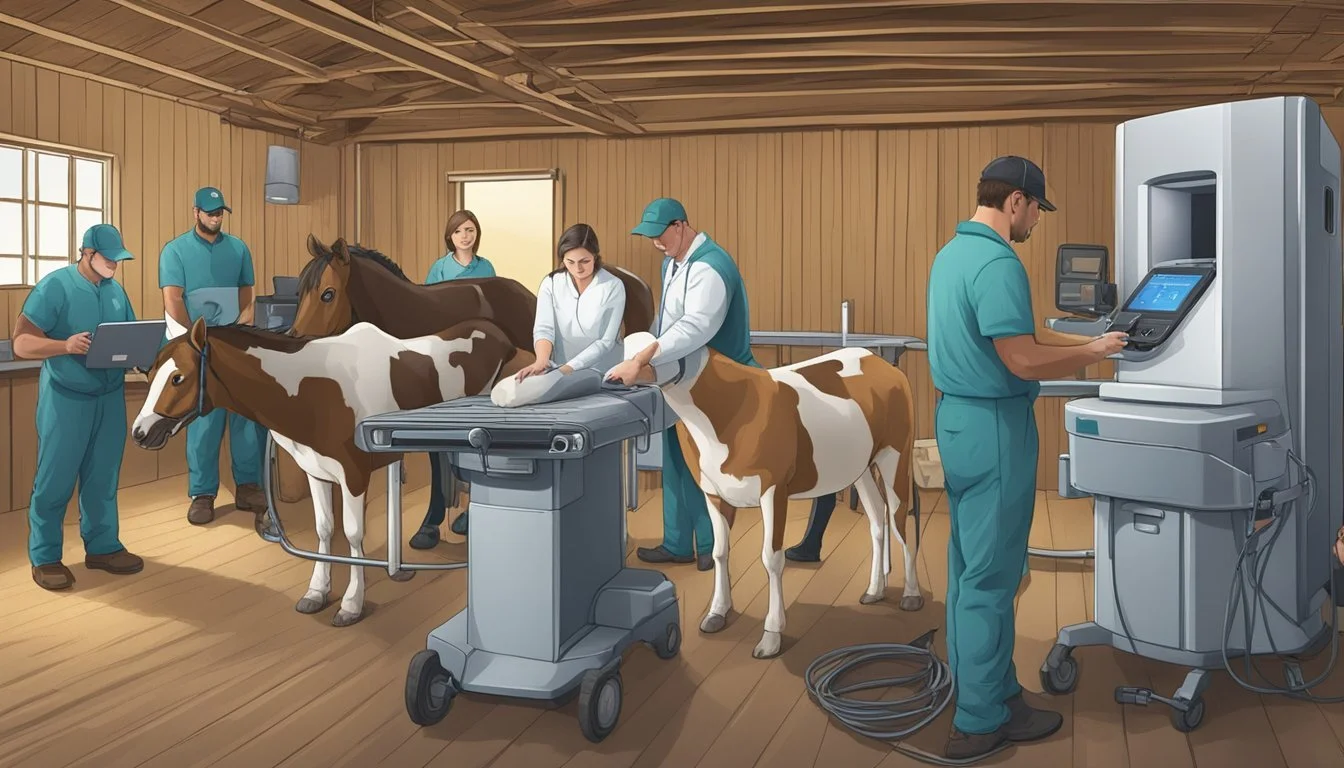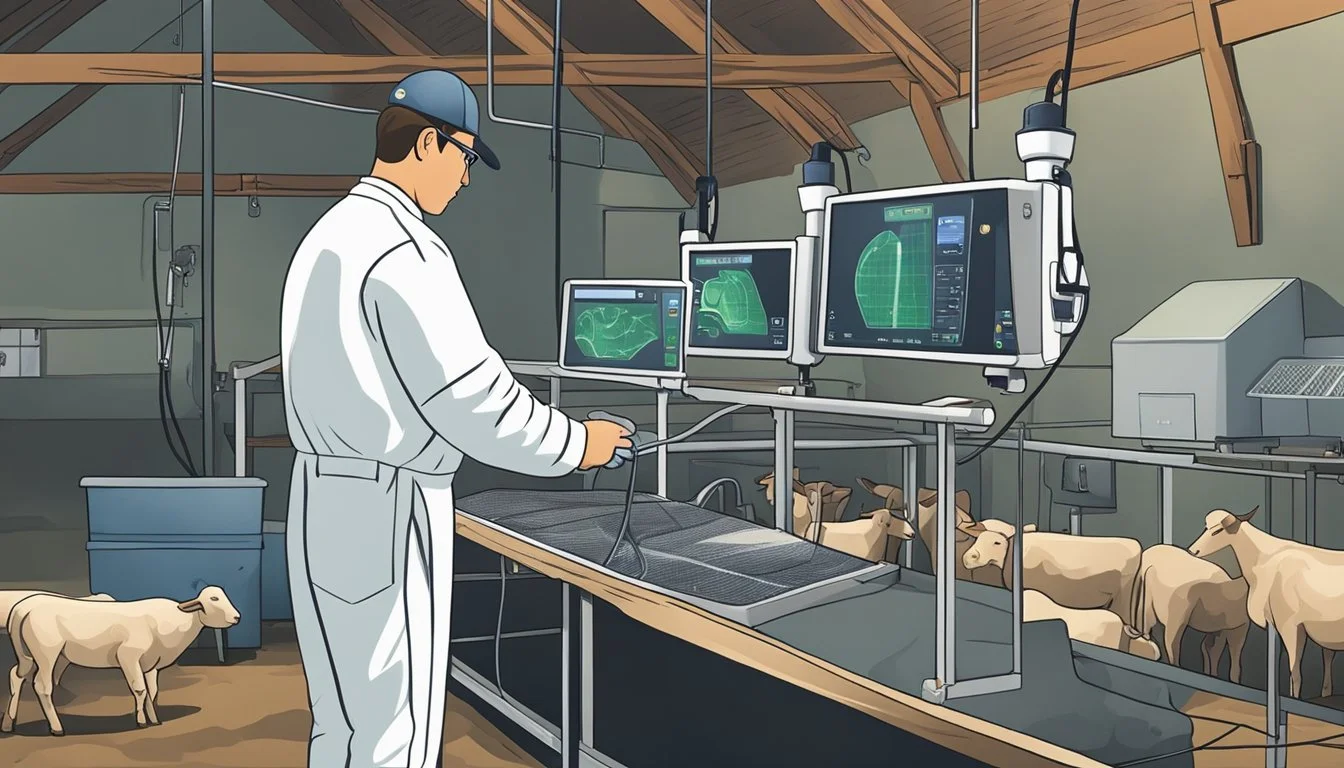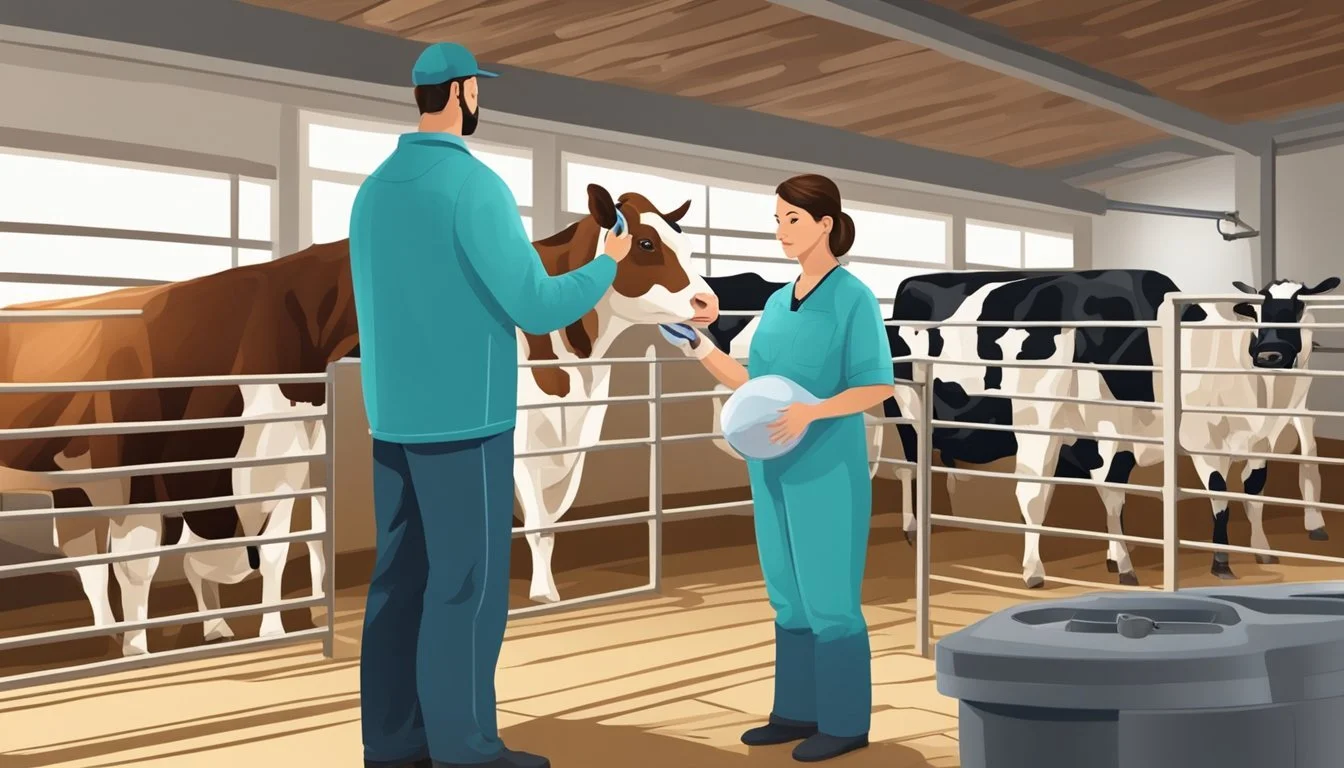The Ultimate Guide to Using Animal Ultrasound Equipment for Pregnancy Checking in Livestock
Expert Tips and Best Practices
Ultrasound technology has revolutionized the management of livestock reproduction, providing farmers with a reliable tool for pregnancy checking. This non-invasive diagnostic method harnesses sound waves to create images of a developing fetus within the womb of livestock. Its accuracy and safety make it an indispensable technique for modern animal husbandry.
The utility of ultrasound extends beyond mere confirmation of pregnancy. It allows for precise fetal aging, an essential factor in managing breeding programs and optimizing herd productivity. Determining the gestational stage of the fetus can also aid in making informed decisions about the management of breeding stock, such as the selection of cattle for artificial insemination programs or the identification of late-calving animals that may require different management strategies.
For livestock producers, employing ultrasound technology is a step toward precision farming—where data-driven insights lead to efficient management and enhanced animal welfare. It is the preferred method not only because it lacks the side effects of radiation-based techniques, but it also offers additional benefits like the capability for fetal sex determination, potentially adding value to the operation. With the right knowledge and equipment, livestock ultrasound can elevate the standard of reproductive management to new heights.
Understanding Ultrasound Technology in Livestock
Ultrasound technology plays a crucial role in livestock management, especially for reproductive assessment and pregnancy checking. It offers a non-invasive, accurate method for evaluating the reproductive status of animals.
Basics of Ultrasound Equipment
Ultrasound equipment functions by emitting high-frequency sound waves that penetrate animal tissue and return echoes, which are then translated into images. The cornerstone of this technology is the transducer probe, which both sends and receives these sound waves. Essential equipment features include:
Frequency Range: Typically between 2 to 10 MHz for optimal imaging depth and resolution.
Real-time Imaging: Provides immediate visualization of muscle and fat layers beneath the animal's hide.
Portability: Compact, durable designs that are easily transportable for field use.
Advancements in Reproductive Ultrasound
Recent developments in reproductive ultrasound have significantly improved the evaluation process. Changes include:
Enhanced Image Quality: Higher resolutions allow for clearer visualization of reproductive structures.
Doppler Capability: Doppler ultrasound can assess blood flow in fetal and maternal vessels, offering insights into fetal health.
Software Upgrades: Advanced software for better quantification and analysis of reproductive traits.
Comparing Ultrasound and Manual Palpation
When it comes to detecting pregnancy, two main methods are ultrasound and manual palpation. Each has its own advantages:
Ultrasound:
Accuracy: High accuracy, especially for early detection.
Training: Requires specialized training to interpret images.
Animal Stress: Generally less stressful for animals.
Equipment: Requires investment in equipment.
Manual Palpation:
Accuracy: Less accurate, particularly in early pregnancy stages.
Training: Requires skill but is more tactile and hands-on.
Animal Stress: Can be more invasive and potentially stressful.
Equipment: No equipment needed beyond personal protective gear.
By harnessing ultrasound technology, practitioners are equipped with a powerful tool that enables precise reproductive management, benefiting the overall productivity of livestock herds.
Preparing for Ultrasound Pregnancy Checking
Before performing ultrasound pregnancy checks on livestock, it's crucial that the facilities are properly set up, safety protocols are established, and the right equipment is selected. Each of these aspects ensures the process is efficient, safe for the animals and operators, and leads to accurate results.
Setting Up the Facilities
Facilities must be prepared in a way that minimizes stress for the animals and allows for easy maneuverability. Chutes or secure enclosures are often employed to safely restrain the animal during the ultrasound. They should be:
Spacious enough for the animal to fit comfortably.
Easily accessible for the operator to perform the ultrasound.
Ensure a clean environment with proper lighting to assist with accurate imaging.
Safety Protocols for Animals and Operators
Safety is paramount for both the livestock and the staff conducting the ultrasounds. Protocols should include:
A method to calm the livestock, which could involve timing procedures after feeding when animals are more docile.
Wearing appropriate personal protective equipment (PPE) such as gloves, goggles, and non-slip footwear.
Training for operators to handle the equipment safely and understand how to secure the animal with minimal stress.
Selecting the Appropriate Ultrasound Equipment
The right ultrasound equipment is essential for obtaining clear images and accurate diagnostics. Selecting the equipment involves:
Real-time ultrasound (RTU) machines that provide instant imaging.
Choosing a transducer that is suitable for the species and size of the animal. High-frequency transducers are typically used for small animals, whereas lower frequencies may be required for larger livestock.
Having backup equipment on hand to avoid interruptions due to technical difficulties.
Executing Pregnancy Testing with Ultrasound
Effective use of ultrasound for pregnancy testing in livestock involves careful execution of the scanning process, accurate interpretation of ultrasound images, and a systematic approach for determining pregnancy status and fetal age.
Performing the Ultrasound Procedure
For the best results in pregnancy testing, producers and veterinarians should adhere to a defined ultrasound technique. They begin by preparing the animal, which may include restraining it properly to ensure safety. The area on the animal's body where the ultrasound probe will be applied should be clean, and in some cases, fur or hair may need to be clipped. A water-based gel is applied to facilitate better contact between the probe and the skin, as this ensures higher image quality.
Equipment Setup:
Frequency Range: Use a probe relevant to the species and size of the animal. For example, a 3.5 to 5.0 MHz range is common for cattle.
Image Adjustment: Set the gain and depth settings on the ultrasound machine to optimize image clarity and focus on the reproductive tract.
Procedure Steps:
Lubricate the ultrasound probe with a conductive gel.
Introduce the probe gently into the animal, typically rectally for most livestock.
Navigate the probe to visualize the uterus and ovaries.
Safety Notes:
Ensure gentle handling to avoid stressing the animal.
For user comfort and animal safety, some devices pair with assistive tools like the ReproArm.
Interpreting Ultrasound Images
The core of ultrasound pregnancy testing lies in the interpretation of the images on the screen. Experienced technicians look for distinct signs of pregnancy, such as the presence of fluid-filled structures (amniotic vesicles), fetal tissues, or fetal movements within the uterus.
Key Indicators:
Amniotic Vesicles: Dark, fluid-filled areas indicating the initial stages of pregnancy.
Fetal Structures: More developed pregnancies show defined body parts of the fetus.
Fetuses at different stages have specific size and structure markers for identification.
Determining Pregnancy Status and Fetal Age
Ultrasound not only can confirm the presence of pregnancy but also estimate the fetal age based on the size and development of the fetus. This estimation is critical for managing breeding programs and predicting calving or lambing dates.
Age Estimation Techniques:
Measurement of Crown-Rump Length: Often used to determine fetal age in the early stage.
Head and Torso Size: In later stages, the measurements of the head or torso provide more accurate age estimates.
Recording Data:
Record the estimated age and expected due date for each animal.
Note any discrepancies in fetal age to assess the efficacy of the breeding program.
Implementing a standardized ultrasound technique enhances pregnancy detection accuracy and improves herd management through strategic planning based on fetal age.
Benefits of Ultrasound Pregnancy Checking
Ultrasound technology has revolutionized pregnancy checking in livestock, offering definitive benefits in terms of diagnosis precision, herd improvement strategies, and cost-effectiveness.
Accuracy and Efficiency in Pregnancy Diagnosis
Ultrasound is acclaimed for its high accuracy in detecting pregnancy. It allows for the early identification of pregnancy as soon as 25 days post-breeding in cattle, establishing the viability and stage of gestation. This level of precision is indispensable for:
Early Decision-making: Detecting non-pregnant animals quickly to manage re-breeding schedules.
Reducing Errors: Minimizing the risk of mistakenly culling pregnant animals or keeping non-pregnant ones.
Improving Herd Management and Genetics
Utilizing ultrasound technology serves as a powerful management tool for genetic selection and herd health. It provides vital information that influences strategies for herd improvement:
Genetic Planning: Determining the success of artificial insemination (A.I.) programs by fetal aging can refine breeding approaches and genetic selection.
Herd Health Insights: Ultrasound might reveal additional reproductive health information, aiding in the management and treatment of potential issues.
Economic Advantages for Farming Operations
In terms of economics, ultrasound pregnancy checking offers several financial benefits for farming operations:
Resource Allocation: Efficiently directs resources by identifying non-pregnant livestock for timely re-breeding or culling.
Cost-Effectiveness: While there is an initial investment in equipment and training, ultrasound can lead to long-term savings through improved herd productivity and reduced labor.
Overall, ultrasound pregnancy checking imparts significant advantages to livestock producers, enhancing management capabilities, productive output, and the economic vitality of farming operations.
Considerations for Different Livestock
When using ultrasound equipment for pregnancy checking in livestock, it's essential to understand the specifics that cater to each type of livestock. Different breeds and purposes of raising livestock may necessitate adaptations in ultrasound techniques to ensure accurate and efficient outcomes.
Ultrasound in Beef Cattle
In beef cattle, ultrasound technology is a game-changer for confirming pregnancy. Producers can quickly identify which cows are unproductive and make informed decisions about managing their herds more effectively. The main considerations for using ultrasound with beef cattle include:
Portability: Equipment must be rugged and portable, as work often occurs in varied and sometimes remote locations.
Affordability: With the cost considerations of running a beef operation, ultrasound units are now more budget-friendly to accommodate the financial constraints of producers.
Time of Scanning: The most accurate time to check beef cattle is between 28 to 35 days after breeding for early detection, and around day 55 to identify twin pregnancies or any fetal anomalies.
Adapting Techniques for Dairy Cows and Heifers
Dairy cows and heifers often require different handling during ultrasound due to their environment and milking schedules. The following outlines specific adaptations:
Handling Stress: Dairy cows can be more accustomed to human contact, yet care must be taken to minimize stress during the procedure.
Timing: The ideal time for pregnancy scans is similar to beef cattle, but adjustments to the schedule may be necessary to accommodate milking routines.
Equipment Calibration: The settings on ultrasound machines might need fine-tuning to account for the dairy cows' specific body condition, which can affect image quality.
For both beef and dairy cattle, it’s vital to use reliable methods to prepare the animal, such as ensuring clean scanning areas and possibly using water or coupling gels to enhance soundwave transmission for clear imagery.
Incorporating Ultrasound into Breeding Programs
Ultrasound technology enhances the efficacy of breeding programs by providing precise information on animal reproductive status. It is instrumental in synchronizing breeding efforts and in the facilitation of artificial insemination and embryo transfer processes.
Synchronization Programs and Ultrasound
In synchronization programs, ultrasounds are used to monitor the ovarian activity of livestock, which allows farmers to synchronize ovulation across the herd. Timing is critical in these programs; thus, the real-time feedback from ultrasound examinations guides producers on the optimal moments to administer hormonal treatments. For example, a producer can detect the presence of corpora lutea or follicles, indicative of different stages of the estrous cycle. Ultrasound use in this context results in:
Efficient use of resources: Reduction in the waste of semen and hormones.
Increased pregnancy rates: Improved timing of insemination leads to higher success rates.
Artificial Insemination and Embryo Transfer
Artificial insemination (AI) benefits from ultrasound by determining the best time for semen deposition, which is critical for enhancing pregnancy outcomes. In embryo transfer programs, ultrasounds assess the recipient cow's health, ensuring that the environment is conducive for the embryo to implant and grow. Ultrasound plays a dual role here:
Reproductive tract assessment: It checks for anomalies that could impede successful implantation.
Pregnancy confirmation: It quickly confirms if the AI or embryo transfer led to pregnancy, enabling prompt decision-making for the next steps in the breeding cycle.
By integrating ultrasound technology into the breeding programs, livestock producers can significantly improve herd reproductive performance while optimizing both labor and material inputs.
Advanced Applications of Ultrasound
Advancements in ultrasound technology have enhanced the capabilities of veterinarians and livestock managers to diagnose and manage animal reproduction with greater precision. By applying these techniques, users can ascertain fetal sex, assess viability, and meticulously monitor ovarian structures throughout reproductive cycles.
Sexing Fetus and Determining Viability
With the implementation of advanced ultrasound methods, fetal sexing can be accurately determined. This technique typically requires timing the ultrasound exam at specific points during gestation, as gender markers become identifiable at certain stages of development. For instance, a bovine fetus's gender can often be established around the 60th day of gestation.
Determining the viability of a fetus is another critical aspect of reproductive management. Ultrasound allows for real-time monitoring of fetal heartbeats and movement. Detecting a heartbeat early in the gestation signifies viability, while consistent monitoring can pick up signs of distress or developmental issues.
Monitoring Ovarian Structures and Cycles
Advanced ultrasonography plays a pivotal role in tracking the ovarian structures and cycles in livestock. By using high-frequency sound waves, veterinarians can visualise and evaluate aspects such as:
Size and number of follicles: Indicates the stage within the estrous cycle.
Corpus luteum development: Gives an insight into ovulation status and luteal function.
Ovarian abnormalities: Helps in diagnosing cysts or other pathologies.
Monitoring these factors is essential for making informed decisions on mating times, diagnosing fertility issues, and managing reproductive health. Regular observation of the estrous cycle ensures optimal breeding strategies and improves the likelihood of successful pregnancies.
Challenges and Limitations
Despite the many benefits of utilizing animal ultrasound equipment for pregnancy checking in livestock, there are notable challenges and limitations that users may encounter. This section discusses the vital considerations regarding operator skill requirements and the intricacies of dealing with late calving and open cows.
Operator Skill and Training Requirements
The success of ultrasounds substantially depends on the skill level of the operator. Trained professionals are necessary because accurately interpreting ultrasound images requires specialized knowledge and experience. The operator must distinguish between various reproductive structures to determine pregnancy status. This competency often requires extensive training, with a steep learning curve for those less experienced.
Dealing with Late Calving and Open Cows
With late calving cows, ultrasound equipment can help in determining the stage of pregnancy, which is critical for making timely management decisions. However, recognizing pregnancy in later stages may be difficult due to the size and position of the calf. On the other hand, identifying open cows – those that are not pregnant – is crucial for culling or re-breeding purposes. The challenge lies in ensuring that non-pregnant cows are accurately identified to prevent unnecessary expenses and optimize the breeding cycle.
Equipment Maintenance and Upkeep
Maintaining animal ultrasound equipment is crucial for accurate pregnancy checking in livestock. Proper cleaning, storage, and performance checks can prolong the lifespan of the equipment and ensure reliable results.
Cleaning and Storing Ultrasound Probes
Cleaning: After each use, the ultrasound probes should be cleaned with a recommended disinfectant. This removes any biological matter and prevents cross-contamination.
Disinfectant solution: Use a non-corrosive, probe-specific solution.
Soft cloth: Wipe gently to avoid damaging the probe.
Storing: When not in use, probes must be stored correctly to avoid damage.
Storage case: Protec the probe from dust and potential impacts.
Environment: Avoid places with extreme temperatures and humidity.
Ensuring Consistent Performance and Reliability
Daily Checks and Calibrations:
Inspect the probe for any visible signs of wear or damage.
Perform routine calibrations to verify that readings are accurate.
Scheduled Maintenance:
Monthly: Test all functions of the ultrasound to identify potential issues.
Yearly: Have a certified technician inspect and service the equipment.
By adhering to these maintenance practices, veterinary practitioners can ensure their ultrasound equipment remains a dependable asset for their practice.
Future and Trends in Pregnancy Ultrasound
The landscape of livestock pregnancy ultrasound is set to transform with the advent of cutting-edge portable devices and the integration of digital technologies, revolutionizing the way veterinarians and farmers monitor animal gestation.
Innovations in Portable Ultrasound Devices
Portable ultrasound equipment has undergone significant advancements, with a focus on enhancing ease of use and image quality. The future for these devices is promising, with significant investments aimed at developing smaller, more efficient systems that can deliver clear and reliable imagery in various field conditions. Such innovations are expected to further drive the adoption and versatility of ultrasound technology in pregnancy checking for livestock.
Efficiency: Lighter and more energy-efficient models are being developed.
Usability: Simplified interfaces are making the devices more user-friendly.
Affordability: Cost-effective solutions are making technology accessible to a broader range of users.
Enhancing Ultrasound with Digital Technologies
The application of digital technology is refining the capabilities of ultrasound equipment. Future trends include:
Image Analysis: Use of AI and machine learning algorithms to enhance image interpretation.
Data Management: Streamlined data collection and sharing through cloud-based systems.
Telemedicine: Expanding remote diagnostics and consultations.
The integration of digital technologies ensures precision in diagnostics and provides robust support for decision-making in animal health management. As digital technology continues to evolve, one can expect even more sophisticated analytical tools and comprehensive data management systems to become integral parts of ultrasound devices.








